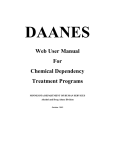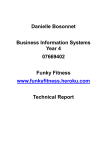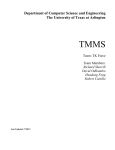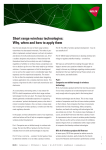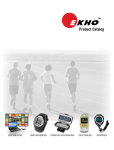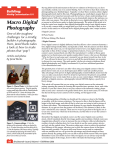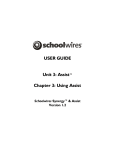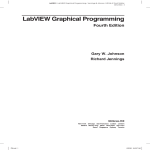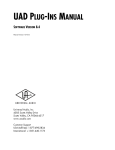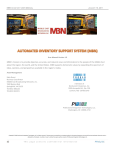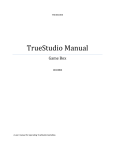Download Undertake Risk Analysis of Activities
Transcript
SISXRSK301A Undertake Risk Analysis of Activities Table of Contents Introduction ...................................................................................................................................... 2 Establish the Context of the Risk Analysis .......................................................................................... 4 1.1 Access the organisation’s records for the activity and location ................................................. 4 1.2 Obtain applicable technical documentation ............................................................................. 9 1.3 Access and clarify risk-evaluation criteria, as determined by the organisation’s risk management policy and plan ......................................................................................................... 9 Identify Risks Associated with an Activity......................................................................................... 10 2.1 Identify and document potential sources of risk for the specific activity and location ............. 10 2.2 Consider and document areas of impact on the organisation ................................................. 11 2.3 Consider and document possible causes of risk and hazards .................................................. 12 Conduct Risk Analysis of an Activity ................................................................................................. 14 3.1 Determine existing organisational controls for each risk according to work health and safety legislation and industry best practice guidelines and standards ................................................... 14 3.2 Assess the likelihood of any given risk turning in an accident, injury or loss ............................ 15 3.3 Assess the consequences of particular incidents in order to determine the degree of emphasis to be placed on the risk ............................................................................................................... 17 3.4 Analyse the likelihood and consequences of particular risks and classification of risk ............. 19 Undertake Risk Assessment of an Activity ........................................................................................ 20 4.1 Compare the level of risk established during the analysis process with previously established risk-evaluation criteria ................................................................................................................. 20 4.2 Rank or prioritise risks for further action, taking account of the wider context of the risk ...... 20 4.3 Consider the objectives of the organisation and the extent of opportunity which could result from taking the risk ..................................................................................................................... 21 4.4 Accept risks that fall into the low or acceptable categories without further treatment ........... 22 Treat Risks Associated with an Activity ............................................................................................ 24 5.1 Identify specific risk treatment options applicable to risks that fall outside the low or acceptable categories .................................................................................................................. 24 5.2 Evaluate risk treatment options according to the organisation’s risk management plan ......... 28 5.3 Documents the activity specific risk action plan ..................................................................... 30 5.4 Implement the risk-action plan prior to and during the activity .............................................. 32 Monitor and Review the Risk Management of an Activity ................................................................ 33 1|P ag e Introduction Every day, everywhere, we are faced with risk. As a Fitness Professional you have a duty of care to try and control or eliminate as many risks as possible in order to keep yourself and your clients safe and free from harm. In order to achieve this, you will be required to undertake a risk analysis of all activities that you conduct within a fitness centre or outdoors. This will involve: Establishing the context of the risk analysis, Identifying risks associated with activities, Conducting risk analysis of all activities, Undertaking risk assessments of all activities, Treating risks associated with activities, and Monitoring and reviewing the risk management of activities. To aid in your learning of risk analysis of activities we are going to use a case study example through this entire chapter to illustrate the steps and requirements or conducting a risk assessment. The case study we are going to use is as follows: Scenario You have been asked by your manager to take over the Boxercise group class that has been running at the centre for the last two (2) years. It was previously managed by another Fitness Professional who has recently left. The manager wants you to give the class an overhaul as there have been issues in the past with injuries. The participants should not be engaging in sparring or other activities that will result in them having physical contact with each other. The class is designed for boxing fitness only where they will be using punching bags, speed balls, and explosive movements to increase their overall fitness. The class will take place in the facilities’ group exercise room which is 30m long and 10m wide. The flooring is carpet. The class will be open to all members of the fitness centre. Before the next class, which is due to run next Monday night, you are required to conduct a risk analysis, and make any changes to the class, that you think will reduce the number of injuries that have been occurring. 2|P ag e Definitions Term Definition Risk The chance of something happening that will have a negative impact on the outcome. Risk is measured in terms of consequence and likelihood. Consequence This is the impact the risk has on human, financial and environmental resources. It is normally measured on a scale from insignificant to catastrophic. Likelihood This is the frequency or probability that the risk will occur. Likelihood is measured on a scale from rare to almost certain. Risk Assessment The identification, evaluation and estimation of the, levels of risks involved in an activity, their comparison against benchmarks or standards, and determination of an acceptable level of risk. Risk Management Process The prioritisation of risks followed by the implementation of change to minimise, monitor and control the consequence and likelihood of the risk. 3|P ag e Establish the Context of the Risk Analysis The first thing that you will need to do in the risk analysis process is to establish the context of the risk analysis. This can be achieved by: Accessing the organisation’s records for the activity and location, Obtaining applicable technical documentation, and Accessing and clarifying risk-evaluation criteria, as determined by the organisation’s risk management policy and plan. 1.1 Access the organisation’s records for the activity and location Every safe, thorough and effective fitness centre will keep records on the risks that are present in their facility, a management process and any breaches of safety that may have resulted in accidents or incidents. Before you can conduct a risk analysis of the Boxercise classes that you are now responsible for, you will need to access Think Health and Fitness’ records for the activity and the location where the activity takes place. These records may include: Equipment maintenance history, Maintenance schedule, Accident and Incident reports, Injury statistics or records, Risk Register, Risk Data Sheets, Risk Treatment Worksheets, Risk Management Action Plan, Failure reports, and Equipment or activity specific policies or procedures. Let’s take a look at the Boxercise case study! When you go to access the records for this activity and location you find that a Risk Analysis has never actually be conducted properly for this activity. What you do find on record are some Accident and Incident Reports that were filled out by the previous Fitness Professional but nothing was ever followed up. Amongst the records you find: Four (4) Accident and Incident Reports in the last 3 months of people who had tripped on some frayed carpet and sustained injuries Three (3) Accident and Incident Reports in the last 3 months of people who had been punched in the head / face whilst holding focus pads for another participant Three (3) Accident and Incident Reports in the last 3 months of people who had hurt their wrists from punching a hard punching bag, and Two (2) Accident and Incident Reports in the last 3 months of people who had hurt their knees or ankles whilst dismounting a spin bike. Examples of these records can be found below: 4|P ag e Accident and Incident Report Use this form to report any workplace accident, injury, illness, near miss, dangerous or. A copy of this form should be retained by you. The form should be reviewed and signed by your supervisor. The original must then be forwarded to the Occupational Health and Safety Officer. Information from the form may be provided to other areas of the organisation such as Risk Management or Facilities. PART A: Details of the person involved in the accident or reporting the hazard Surname: Carey Given Names: James John Date of Birth: 17/5/1971 Sex: M F Status: Management Staff: General Staff: X Client: Contractor / Employed by Contractor: Visitor: Phone Number: 0405 687 495 Address: 12 Boundary Road, Pleasentville PART B: Details of the accident or incident Date of accident: 1 January and Time: 5:00 am/pm Where did the event happen? Be specific, e.g. group fitness room: Group Fitness Room 1 Describe the accident: task being performed, sequence of events, unexpected event, or hazard: the nature and seriousness of the hazard James was doing shuttle runs through the centre of the boxing circuit and he tripped on a frayed patch of carpet. The patch of carpet is about 25 cm x 15 cm and has exposed concrete underneath. The edge of the frayed carpet is sticking up. Witness (if any): Katie Smyth and Simon Reynolds PART C: Details of the injury / illness if any Type(s) of injury/illness e.g. strain, cut , burn Part(s) of the body injured: specify left/right where appropriate Carpet burn on right knee and strained wrists (both) Right knee and both wrists Injury event: what action/exposure/event directly caused the injury/illness. Injury agent: What object/substance/circumstances were directly involved Participant was running and not watching where they were going Frayed carpet formed a trip hazard Please note, if possible, the seriousness of injury: very low (1)> medium (3) >very high (5): 2 PART D: Please note, if applicable, Cause(s) of Accident/Incident: Human Error Maintenance Failure Other: Please specify: X Poor Design Procedures Not Adequate Procedures Not Followed Random Event Training Not Adequate Sport Activity __________________________________________________________________________________________________ Part E: Actions recommended / taken to prevent re-occurrence or remove hazard: Replace or repair equipment/area X Improve Design Clean up Use safer alternative materials Provide training Improve signage or markings Consult with workers Establish safe working procedure Improve or increase supervision Install safety devices No action necessary Details of action taken to prevent re-occurrence / remove hazard (and who by/when by?): During the session the Instructor (Craig) moved the shuttle run track and put markers over the frayed carpet so no one else tripped on it. Supervisor: __________________________________ Date: ____________ Extension: ________ Treatments: None First Aider X University Nurse Doctor Ambulance Hospital Other ______________________ __ Outcome: Continued Returned next day Absent more than 1 day Unknown X Name of the person completing this form Name: Craig Burrows (Instructor) 5|P ag e Date: 4 January Admitted to hospital? Yes No X Accident and Incident Report Use this form to report any workplace accident, injury, illness, near miss, dangerous or. A copy of this form should be retained by you. The form should be reviewed and signed by your supervisor. The original must then be forwarded to the Occupational Health and Safety Officer. Information from the form may be provided to other areas of the organisation such as Risk Management or Facilities. PART A: Details of the person involved in the accident or reporting the hazard Surname: Conway Status: Given Names: Jacinta Elizabeth Management Staff: General Staff: Sex: M Date of Birth: 13/9/1979 X Client: Contractor / Employed by Contractor: F Visitor: Phone Number: 0405 111 222 Address: 1223 Southwest Road, Pleasentville PART B: Details of the accident or incident Date of accident: 14 January and Time: 5:00 am/pm Where did the event happen? Be specific, e.g. group fitness room: Group Fitness Room 1 Describe the accident: task being performed, sequence of events, unexpected event, or hazard: the nature and seriousness of the hazard Jacinta was paired with Chloe Jacobs for boxing. Jacinta was holding the focus pads and Chloe was punching them. Jacinta looked away and Chloe missed the pads and punched Jacinta in the side of the face. Witness (if any): Chloe Jacobs PART C: Details of the injury / illness if any Type(s) of injury/illness e.g. strain, cut , burn Part(s) of the body injured: specify left/right where appropriate Bruising Right cheek Injury event: what action/exposure/event directly caused the injury/illness. Injury agent: What object/substance/circumstances were directly involved Being struck in the face by another participant Another participant Please note, if possible, the seriousness of injury: very low (1)> medium (3) >very high (5): 3 PART D: Please note, if applicable, Cause(s) of Accident/Incident: Human Error X Maintenance Failure Other: Please specify: Poor Design Procedures Not Adequate Procedures Not Followed Random Event Training Not Adequate X Sport Activity __________________________________________________________________________________________________ Part E: Actions recommended / taken to prevent re-occurrence or remove hazard: Replace or repair equipment/area Improve signage or markings Improve Design Consult with workers Clean up Establish safe working procedure X Use safer alternative materials Improve or increase supervision Provide training Install safety devices X No action necessary Details of action taken to prevent re-occurrence / remove hazard (and who by/when by?): During the session the Instructor (Craig) ensured everyone was paying attention when their partner was punching the focus pads Supervisor: __________________________________ Date: ____________ Extension: ________ Treatments: None First Aider X University Nurse Doctor Ambulance Hospital Other ______________________ __ Outcome: Continued Returned next day Absent more than 1 day Unknown X Name of the person completing this form Name: Craig Burrows (Instructor) 6|P ag e Date: 22 January Admitted to hospital? Yes No X Accident and Incident Report Use this form to report any workplace accident, injury, illness, near miss, dangerous or. A copy of this form should be retained by you. The form should be reviewed and signed by your supervisor. The original must then be forwarded to the Occupational Health and Safety Officer. Information from the form may be provided to other areas of the organisation such as Risk Management or Facilities. PART A: Details of the person involved in the accident or reporting the hazard Surname: Halloway Given Names: Elizabeth Jane Status: Management Staff: General Staff: Sex: M Date of Birth: 01/01/1982 X Client: Contractor / Employed by Contractor: F Visitor: Phone Number: 0403 347 874 Address: 1/33 Vulture Terrace, Pleasentville PART B: Details of the accident or incident Date of accident: 4 January and Time: 5:00 am/pm Where did the event happen? Be specific, e.g. group fitness room: Group Fitness Room 1 Describe the accident: task being performed, sequence of events, unexpected event, or hazard: the nature and seriousness of the hazard Elizabeth was new to the class. She was punching the floor to ceiling punching bag. The class was given the direction to ‘go hard’. Elizabeth increased the intensity and at the end mentioned that her wrist hurt when she punched. Witness (if any): n/a PART C: Details of the injury / illness if any Type(s) of injury/illness e.g. strain, cut , burn Part(s) of the body injured: specify left/right where appropriate Strain Left and right wrist Injury event: what action/exposure/event directly caused the injury/illness. Injury agent: What object/substance/circumstances were directly involved Punching the hard bag Punching bag Please note, if possible, the seriousness of injury: very low (1)> medium (3) >very high (5): 3 PART D: Please note, if applicable, Cause(s) of Accident/Incident: Human Error Maintenance Failure Other: Please specify: Poor Design Procedures Not Adequate Procedures Not Followed Random Event Training Not Adequate X Sport Activity __________________________________________________________________________________________________ Part E: Actions recommended / taken to prevent re-occurrence or remove hazard: Replace or repair Improve Use safer alternative Clean up equipment/area Design materials Improve signage Consult with Establish safe Improve or increase or markings workers working procedure supervision Details of action taken to prevent re-occurrence / remove hazard (and who by/when by?): Provide training Install safety devices X No action necessary During the session the Instructor (Craig) allowed Elizabeth to skip the punching stations and just skip instead. Supervisor: __________________________________ Date: ____________ Extension: ________ Treatments: None X First Aider University Nurse Doctor Ambulance Hospital Other ______________________ __ Outcome: Continued Returned next day Absent more than 1 day Unknown X Name of the person completing this form Name: Craig Burrows (Instructor) 7|P ag e Date: 15 January Admitted to hospital? Yes No X Accident and Incident Report Use this form to report any workplace accident, injury, illness, near miss, dangerous or. A copy of this form should be retained by you. The form should be reviewed and signed by your supervisor. The original must then be forwarded to the Occupational Health and Safety Officer. Information from the form may be provided to other areas of the organisation such as Risk Management or Facilities. PART A: Details of the person involved in the accident or reporting the hazard Surname: Halloway Given Names: Peter James Date of Birth: 19/01/1982 Sex: M F Status: Management Staff: General Staff: X Client: Contractor / Employed by Contractor: Visitor: Phone Number: 0403 347 444 Address: 1/33 Vulture Terrace, Pleasentville PART B: Details of the accident or incident Date of accident: 6 February and Time: 5:00 am/pm Where did the event happen? Be specific, e.g. group fitness room: Group Fitness Room 1 Describe the accident: task being performed, sequence of events, unexpected event, or hazard: the nature and seriousness of the hazard Peter was on the spin bike, when the station changed, he took his feet out of the pedal without letting it stop spinning. In doing so, his feet got caught up in the pedals that were spinning very fast. It avoid injury he allowed his knees to fall away to the side and scrapped his right knee on the wall, tasking skin off. The bike was lined up in the corner about 30 cm from the wall. Witness (if any): n/a PART C: Details of the injury / illness if any Type(s) of injury/illness e.g. strain, cut , burn Part(s) of the body injured: specify left/right where appropriate Cut and graze and bruise Right knee Injury event: what action/exposure/event directly caused the injury/illness. Injury agent: What object/substance/circumstances were directly involved Dismounting the bike incorrectly Spin bike and wall Please note, if possible, the seriousness of injury: very low (1)> medium (3) >very high (5): 3 PART D: Please note, if applicable, Cause(s) of Accident/Incident: Human Error Maintenance Failure Other: Please specify: Poor Design X Procedures Not Adequate Procedures Not Followed Random Event Training Not Adequate X Sport Activity __________________________________________________________________________________________________ Part E: Actions recommended / taken to prevent re-occurrence or remove hazard: X Replace or repair Improve Use safer alternative Clean up equipment/area Design materials Improve signage Consult with Establish safe Improve or increase or markings workers working procedure supervision Details of action taken to prevent re-occurrence / remove hazard (and who by/when by?): Provide training Install safety devices X No action necessary During the session the Instructor (Craig) allowed Elizabeth to skip the punching stations and just skip instead. Supervisor: __________________________________ Date: ____________ Extension: ________ Treatments: None X First Aider University Nurse Doctor Ambulance Hospital Other ______________________ __ Outcome: Continued Returned next day Absent more than 1 day Unknown X Name of the person completing this form Name: Craig Burrows (Instructor) 8|P ag e Date: 15 January Admitted to hospital? Yes No X 1.2 Obtain applicable technical documentation As a Fitness Professional you will need to know the ins and outs of how to use all fitness equipment safely. Not all equipment is equal. For example a Life Fitness Treadmill is very different to a York or a Lifespan Treadmill. It is your responsibility to ensure that you know all the safety features of every piece of equipment prior to working with clients. Generally, during your workplace induction you will be shown how to safely use all the equipment. Whilst you may be working around very experienced people, ensure you access the technical documentation for all equipment and read thoroughly about all safety requirements. At purchase, all commercial fitness equipment comes with a User Guide or Technical Documentation. This documentation will generally outline the following information: Assembly and installation instructions, Operation instructions, Safety information and instructions, Maintenance instructions, and Warranty information. To get an idea of the type of useful information that is included in these technical documents. To download the Keiser m3+ Spin Bike – User Manual go to: http://manuals.keiser.com/downloads/exercise_bikes/M3-M3+-User-Manual.pdf Your workplace will have all these technical documents on file for you to access and read. 1.3 Access and clarify risk-evaluation criteria, as determined by the organisation’s risk management policy and plan The last type of information that you will need to access before you can start your risk analysis of the Boxercise class is the risk – evaluation criteria as determined by the organisations Risk Management Policy and Plan. Risk – evaluation criteria may include: Legislation, Regulations, Australian standards, Organisational polices, aims and objectives, and Operating procedures and guidelines. Click here to access an example fitness Risk Management Plan. Ensure you read this document carefully. 9|P ag e Identify Risks Associated with an Activity Now that you have established the context for the risk analysis by accessing a range of records and documentation, you can work on identifying the associated risks with the Boxercise class. This can be achieved by: Identifying and documenting potential sources of risk for the specific activity and location, Considering and documenting areas of impact on the organisation, and Considering and documenting possible causes of risk and hazards. 2.1 Identify and document potential sources of risk for the specific activity and location Your first task is to identify and document the potential sources of risk for the specific activity and location. As a general rule, potential sources of risk can be categorised as: physical; psychological; chemical; environmental, behavioural; and financial, commercial and legal. Below you will see a number of different types of risks. Potential sources of risk include: Physical, o Uneven surfaces o Poor work station design o Wet or slippery surfaces o Blocked walkways o Repetition of movement Psychological, o Working alone o Being over or under worked o No procedures o Split shifts Chemical, o Chemical storage o Flammable substances o Corrosive substances Environmental, o Being exposed to the sun o Poor ventilation o Working in the extreme heat or cold o Working in wind and rain Behavioural, o Poor leadership o Bullying or harassment o Violence in the workplace Financial, commercial, and Legal o Information insecurity o Breaches to privacy and confidentiality o Breaches to health and safety 10 | P a g e Clients tripping on uneven surfaces Clients being punched Clients injuring their wrists Clients scraping their knees 001 Description Risk Rating Ref No. Consequence Potential Risk Likelihood The first thing we need to do is open a new Risk Register. Now we can go back through each of the Accident and Incident forms that were filled out by Craig, the last Boxercise Instructor and identify all the risks that were identified. These can all be listed in Column A – Potential Risks. In Column B – Ref No. we can allocate a reference number to this risk. This number will differ from organisation to organisation. See below for an example: Impact Criteria Existing Controls Agreed Priority Transfer to Risk Action Plan Refer to Risk Chart 002 003 004 2.2 Consider and document areas of impact on the organisation The next step is to consider and document the areas of impact on the organisation. Again, each organisation will have their own groups or categories for areas of impact. Think Health and Fitness’ areas of impact are: Safety, Financial, Image and Reputation, and Compliance. This relates to the area of the business that is most affected by the risk or hazard. All areas are interrelated. For example, if lots of people start getting hurt during the group exercise classes, the numbers of participants will drop off. Clients will start talking negatively about an Instructor or particular class to people outside the fitness centre. This may result in poor image and reputation. Participants may leave the facility and join somewhere else, which in turn will affect the fitness centre financially. Participants may even report the fitness facility to the governing body if they are in breach of health and safety, which will affect their compliance. In our Boxercise class example, we can now fill out Column G – Impact Criteria. In this case, all of the risks are directly related to client safety. 11 | P a g e Risk Rating Description Consequence Ref No. Likelihood Potential Risk Impact Criteria Existing Controls Agreed Priority Transfer to Risk Action Plan Refer to Risk Chart Clients tripping on uneven surfaces Clients being punched Clients injuring their wrists Clients scraping their knees 001 Safety 002 Safety 003 Safety 004 Safety 2.3 Consider and document possible causes of risk and hazards Risk Rating Consequence Potential Risk Likelihood The final thing we need to do in identifying risks is to consider and document possible causes of risks. These are considered the hazards or the things / aspects that cause the risk. This information is often contained within the Accident and Incident Report, however, at times, it may be a need to further investigation. We can put this information in Column C – Description. Ref No. Impact Criteria Description 001 Frayed carpet, exposed concrete, trip hazard Safety 002 Clients holding focus pads Safety Refer to Risk Chart Clients tripping on uneven surfaces Clients being punched Clients injuring their wrists 003 Clients scraping their knees 004 12 | P a g e Clients punching a bag with no training Clients dismounting equipment incorrectly / equipment placed inappropriately Safety Safety Existing Controls Agreed Priority Transfer to Risk Action Plan We will continue our risk assessment in the next section. Some other common risks / hazards and their possible causes that are common in the fitness industry include: Clients tripping on equipment caused by people leaving equipment on the floor Clients slipping on wet tiles caused by people spilling protein drinks on the floor Equipment breaking cause by people not using it how it is designed Staff having car accidents caused by working long shifts and not having sufficient breaks Mirrors breaking caused by clients throwing dumbbells around Floor boards breaking caused by clients dropping heavy weights People being electrocuted caused by a failure to have electrical cords inspected regularly 13 | P a g e Conduct Risk Analysis of an Activity Now that we have identified the risks involved in the activity, we can conduct the risk analysis. In doing so, it is important to: Determine existing organisational controls for each risk according to work health and safety legislation and industry best practice guidelines and standards, Assess the likelihood of any given risk turning in an accident, injury or loss, Assess the consequences or particular incidents in order to determine the degree of emphasis to be placed on the risk, and Analyse the likelihood and consequences of particular risks and classification of risk. 3.1 Determine existing organisational controls for each risk according to work health and safety legislation and industry best practice guidelines and standards The next task is to determine any controls that may already be in place for each risk according to work health and safety legislation and industry best practice guidelines and standards. Controls are generally categorised as: Elimination (avoidance or discontinuance) Substitution Isolation Safeguards Education and Training Use of PPE The types of actions that may result can involve: Education & Training Policy &/or Procedural amendments Audits Contingency planning Risk transfer (including insurance) These controls will be contained within the organisation’s past risk registers policies and procedures. We know from the Boxercise example that there have been multiple accidents and incidents in the Boxercise classes recently. We also know that the last Instructor reported the incidents sometimes 1 to 2 weeks after they actually occurred. We also know that these were never followed up. Therefore, we need to work together to come up with some controls to stop these accidents and incidents from occurring again. On the Risk Register we need to record any controls that are currently in place to minimise the risk. We have identified that there are none currently. Therefore, in Column H – Existing Controls: 14 | P a g e Risk Rating Description Consequence Ref No. Likelihood Potential Risk Impact Criteria Existing Controls 001 Frayed carpet, exposed concrete, trip hazard Safety None 002 Clients holding focus pads Safety None Safety None Safety None Agreed Priority Transfer to Risk Action Plan Refer to Risk Chart Clients tripping on uneven surfaces Clients being punched Clients injuring their wrists 003 Clients scraping their knees 004 Clients punching a bag with no training Clients dismounting equipment incorrectly / equipment placed inappropriately 3.2 Assess the likelihood of any given risk turning in an accident, injury or loss We know from past Accident and Incident Reports that these risks occur frequently in the past. Now it is time to assess the likelihood of these risks occurring again in the future if we don’t make any changes. There are many different types of ‘likelihood scales’ and every organisation will have their own. According to the Think Health and Fitness Risk Management Plan, they measure likelihood as follows: Likelihood Rating Scale Level Rating 1 Rare Likelihood Description Very unlikely but not impossible Frequency Less than once in 15 years 2 Unlikely Plausible, could occur at sometime At least once in 10 years 3 5 Almost Certain Reasonable likelihood to occur at sometime High probability of occurring in most circumstances Will probably occur in most circumstances At least once in 5 years 4 Possible / Moderate Likely At least once per year More than once per year We know that each of the risks in our Risk Register have occurred multiple times in the last few months and according to the likelihood scale this means they all rate ‘5’, therefore we can fill out Column D – Likelihood as follows: 15 | P a g e 001 Frayed carpet, exposed concrete, trip hazard 002 Clients holding focus pads Risk Rating Description Consequence Ref No. Likelihood Potential Risk Impact Criteria Existing Controls 5 Safety None 5 Safety None 5 Safety None 5 Safety None Refer to Risk Chart Clients tripping on uneven surfaces Clients being punched Clients injuring their wrists 003 Clients scraping their knees 004 16 | P a g e Clients punching a bag with no training Clients dismounting equipment incorrectly / equipment placed inappropriately Agreed Priority Transfer to Risk Action Plan 3.3 Assess the consequences of particular incidents in order to determine the degree of emphasis to be placed on the risk The next step is to assess the consequences of particular incidents to determine the degree of emphasis that need to be placed on the risk. Again, there are many different types of ‘consequence scales’ and every organisation will have their own. According to the Think Health and Fitness Risk Management Plan, they measure consequence as follows: Consequence Rating Scale Safety Level 1 2 3 4 5 Rating Negligible (rectified by normal processes) Minor (easily remedied with some effort) Moderate (considerable effort to rectify) Major (requires intervention of top level management) Catastrophic (threatens survival) Impact Image and Financial Reputation Compliance (effect on Operations) Persons Property No injury No damage Less than $1,000 Low Impact Less than 1 hour Internal repair $1,000 $10,000 Low Impact 1 hr – 1 day External repair $10,000 $50,000 Moderate Impact 1 day – 1 week Extensive external repairs $50,000 $150,000 High Impact 1 week – 1 month More than $150,000 Extreme Impact More than 1 month First aid treatment required Medical treatment required Death or extensive injuries Multiple deaths or Unrepairable severe / replace permanent disablements We know that each of the risks in our Risk Register have resulted in injury and equipment damage, this means they are all rated either ‘2’ or ‘3’, therefore we can fill out Column E – Consequences as follows: 17 | P a g e Description 001 Frayed carpet, exposed concrete, trip hazard 5 002 Clients holding focus pads Risk Rating Ref No. Consequence Likelihood Potential Risk Impact Criteria Existing Controls 3 Safety None 5 2 Safety None 5 2 Safety None 5 2 Safety None Refer to Risk Chart Clients tripping on uneven surfaces Clients being punched Clients injuring their wrists 003 Clients scraping their knees 004 18 | P a g e Clients punching a bag with no training Clients dismounting equipment incorrectly / equipment placed inappropriately Agreed Priority Transfer to Risk Action Plan 3.4 Analyse the likelihood and consequences of particular risks and classification of risk Ref No. Description 001 Frayed carpet, exposed concrete, trip hazard 5 3 002 Clients holding focus pads 5 Risk Rating Consequence Potential Risk Likelihood The next step is to calculate the Risk Rating, this is done by simply multiplying the ‘likelihood’ with the ‘consequence’. We can now fill out Column F – Risk Rating. Impact Criteria Existing Controls 15 Safety None 2 10 Safety None 5 2 10 Safety None 5 2 10 Safety None Agreed Priority Transfer to Risk Action Plan Refer to Risk Chart Clients tripping on uneven surfaces Clients being punched Clients injuring their wrists 003 Clients scraping their knees 004 Clients punching a bag with no training Clients dismounting equipment incorrectly / equipment placed inappropriately Many workplaces will classify risks according to the outcome of the risk occurring. Some common classifications of risk include: Diseases Economic perils Environmental Financial Human perils Natural perils Work Health and Safety product liability Professional liability Property damage Public liability Security Technology 19 | P a g e Undertake Risk Assessment of an Activity Now that we have established the context of the risk analysis; identified risks associated with activities; and conducted risk analysis of all activities; we can undertake the risk assessment of the activity. In doing so, we will be: Comparing the level of risk established during the analysis process with previously established risk-evaluation criteria, Ranking or prioritising risks for further action, taking account of the wider context of the risk, Considering the objectives of the organisation and the extent of opportunity which could result from taking the risk, and Accepting risks that fall into the low or acceptable categories without further treatment. 4.1 Compare the level of risk established during the analysis process with previously established risk-evaluation criteria In order to monitor any change in level of risk over time, it is important to compare the level of risk established during the analysis process with previously established risk-evaluation criteria. This can be done quickly and easily by comparing the risks on the current Risk Register with those of previous Risk Registers. We have already established that Risk Registers were not implemented and kept on file for this particular activity. 4.2 Rank or prioritise risks for further action, taking account of the wider context of the risk The next step in the process is to rank or prioritise all risks for further action. In doing so, it is important to take into account the wider context of the risk. In a previous chapter we were able to calculate the Risk Rating for each risk by multiplying the ‘likelihood’ with the ‘consequence’. From this information we are able to establish some criteria for the management of risk. At Think Health and Fitness this is done by: Risk Rating Scale; Likelihood x Consequences = Level of Risk Level of Risk Criteria for Management of Risk 1–3 Acceptable 4–5 Monitor 6–9 Management Control Required 10 – 14 Urgent Management Attention 15 – 25 Unacceptable Using the table above, we can now decide on the agreed priority in Column I – Agreed Priority 20 | P a g e Ref No. Description Clients tripping on uneven surfaces 001 Frayed carpet, exposed concrete, trip hazard 5 3 Clients being punched 002 Clients holding focus pads 5 Risk Rating Consequence Likelihood Potential Risk Impact Criteria Existing Controls 15 Safety None 2 10 Safety None 5 2 10 Safety None 5 2 10 Safety None Agreed Priority Transfer to Risk Action Plan Refer to Risk Chart Clients injuring their wrists 003 Clients scraping their knees 004 Clients punching a bag with no training Clients dismounting equipment incorrectly / equipment placed inappropriately Urgent Management Attention Urgent Management Attention Urgent Management Attention Urgent Management Attention 4.3 Consider the objectives of the organisation and the extent of opportunity which could result from taking the risk Once all the risk have been prioritised the objectives of the workplace or organisation need to be considered. In doing so, it is important to think about the extent of opportunity or outcome that could result from taking the risk. For example, let’s take the Boxercise class example: Let’s say the fitness centre has done a complete financial audit and they have discovered that group classes don’t really make much money for the organisation and management have decided to shift their attention and energies away from group classes and onto Personal Training and gym membership sales. If this is the case they may choose to accept the risks that you uncovered during your risk analysis of the Boxercise Classes because it is not important to the overall functionality of the fitness centre. On the other hand if management found that group classes were valuable and were their major source of income for the club, they would be more likely to spend the money and time fixing the facility and training staff to try and grow the number of participants attending group classes. This can be frustrating for Fitness Professionals because at times there will be changes required within a fitness facility that they deem to be important for the safety and interest of the members and clients however unless management deem that it is in line with their organisational objectives, change may not occur. 21 | P a g e 4.4 Accept risks that fall into the low or acceptable categories without further treatment Risk Rating Consequence Potential Risk Likelihood Now it is time to decide if we are prepared to accept the risk or whether they need to be referred on for further treatment. It is best practice to accept risks that fall into the low or acceptable categories without further treatment. In relation to our example, on page 6 of the Think Health and Fitness Risk Management Plan, under section ‘3.5 Treating Risks’ it reads “Risk treatment determines what can be done in response to the risks that have been identified, with a risk rating of 6 or higher, to reduce, transfer, or eliminate the risk by implementing new controls or enhancing existing controls”. All the risk that we identified on our Risk Register had a Risk Rating of either 10 or 15, therefore they all need to be transferred to the Risk Action Plan, as per Column J – Transfer to Risk Action Plan” Ref No. Description Impact Criteria Existing Controls Clients tripping on uneven surfaces 001 Frayed carpet, exposed concrete, trip hazard 5 3 15 Safety None Clients being punched 002 Clients holding focus pads 5 2 10 Safety None 5 2 10 Safety None Agreed Priority Transfer to Risk Action Plan Refer to Risk Chart Clients injuring their wrists Clients scraping their knees 003 004 Clients punching a bag with no training Clients dismounting equipment incorrectly / equipment placed inappropriately 5 2 10 Safety None Urgent Management Attention Urgent Management Attention Urgent Management Attention Urgent Management Attention Yes Yes Yes Yes From above, it has been established that there is a requirement for all the risks to be transferred to a Risk Action Plan as urgent management attention is required. This can be done by filling out Column A – Risk. 22 | P a g e Risk Action Plan Risk (include Risk register number) Date Entered 001 - Clients tripping on uneven surfaces – Frayed carpet in group exercise room 002 - Clients being punched Clients holding focus pads 003 - Clients injuring their wrists - Clients punching a bag with no training 004 - Clients scraping their knees - Clients dismounting equipment incorrectly / equipment placed inappropriately 23 | P a g e 5 Feb 5 Feb 5 Feb 5 Feb Treatment Actions Recommended Responsible Timeframe Completed (sign off) Treat Risks Associated with an Activity The next step in the risk analysis process is to treat the risks that are associated with an activity. This needs to include the following: Identifying specific risk treatment options applicable to risks that fall outside the low or acceptable categories, Evaluating risk treatment options according to the organisation’s risk management plan Documenting the activity specific risk treatment plan, Implementing the risk-treatment plan prior to and during the activity. 5.1 Identify specific risk treatment options applicable to risks that fall outside the low or acceptable categories In the previous chapter we left off by transferring all risks that fell outside the low or acceptable categories onto a Risk Action Plan. Column C – Treatment Actions Recommended requires us to put forward our recommendations for treating or managing this risks. Risk Action Plan Risk (include Risk register number) Date Entered 001 - Clients tripping on uneven surfaces – Frayed carpet in group exercise room 002 - Clients being punched Clients holding focus pads 5 Feb 5 Feb 003 - Clients injuring their wrists - Clients punching a bag with no training 004 - Clients scraping their knees - Clients dismounting equipment incorrectly / equipment placed inappropriately 24 | P a g e 5 Feb 5 Feb Treatment Actions Recommended Responsible Timeframe Completed (sign off) According to the Think Health and Fitness Risk Management Plan, treatment strategies will aim to achieve one or a combination of the following outcomes: Elimination (avoidance or discontinuance) Substitution Isolation Safeguards Education and Training Use of PPE The best way to fix a hazard is to get rid of it altogether. This is not always possible, but your employer should try to make hazards less dangerous by looking at the following options (in order from most effective to least effective): Elimination Sometimes hazards - equipment, substances or work practices - can be avoided entirely. (e.g. Clean high windows from the ground with an extendable pole cleaner, rather than by climbing a ladder and risking a fall.) Substitution Sometimes a less hazardous thing, substance or work practice can be used. (e.g. Use a non-toxic glue instead of a toxic glue.) Isolation Separate the hazard from people, by marking the hazardous area, fitting screens or putting up safety barriers. (e.g. Welding screens can be used to isolate welding operations from other workers. Barriers and/or boundary lines can be used to separate areas where forklifts operate near pedestrians in the workplace.) Safeguards Safeguards can be added by modifying tools or equipment, or fitting guards to machinery. These must never be removed or disabled by workers using the equipment. Instructing workers in the safest way to do something This means developing and enforcing safe work procedures. Students on work experience must be given information and instruction and must follow agreed procedures to ensure their safety. Using personal protective equipment and clothing (PPE) If risks remain after the options have been tried, it may be necessary to use equipment such as safety glasses, gloves, helmets and ear muffs. PPE can protect you from hazards associated with jobs such as handling chemicals or working in a noisy environment. Sometimes, it will require more than one of the risk control measures above to effectively reduce exposure to hazards. Information about risk control measures can be obtained from: ● ● regulations, National Commission codes of practice and guidance material; consulting with employees; ● employer organisations and unions; 25 | P a g e ● government authorities; ● occupational health and safety specialists Risk management needs to be systematic and proactive and the common types of actions that may result can involve: Education & Training Policy &/or Procedural amendments Audits Contingency planning Risk transfer (including insurance) Where a number of treatment options may be available, a “Risk Treatment Worksheet” may be utilised to record these. Let’s take one of the risk that were discovered in the Boxercise Scenario. Risk 002 – clients being punched in the face and head while holding the focus pads for other clients. 26 | P a g e Risk Treatment Worksheet Type of Risk Identified? (please record impact criteria from Risk Register) Financial Image and Reputation Compliance Safety (direct or indirect (breaching of legal or (injury or damage to financial loss) other obligations) persons or property) X ☐ ☐ ☐ Description Clients being punched from holding focus pads while other clients punch them Reference Number (from risk register) 002 Likelihood Rating Consequence Rating Risk Rating 5 2 10 Current Controls (please list) The Instructor tells all clients to be careful at the beginning of the session Possible Treatment Actions 1. Give all clients training on safety around holding the focus pads (Training) Consideration Points (benefits, costs, resources) This is time consuming, not all clients come to all sessions, new clients come to classes all the time, it is not designed to be a technical class but about fitness This is too costly and there are not enough instructors 2. Get other Instructors in to hold the focus pads as they have had training (Resources) 3. Stop the activity and have clients only Not as many people can be boxing at the same punching fixed bags (Eliminate) time Comments and Recommendations Option 3. Is the best option as it will eliminate their issue altogether. The class is more about fitness then it is about boxing. Date Compiled By Name: Jamie Smith 25 February Signature: JESmith 27 | P a g e 5.2 Evaluate risk treatment options according to the organisation’s risk management plan When there are multiple possible treatment options identified in a Risk Treatment Worksheet, the person filling out the worksheet will give their recommendations. This however, needs to be decided by management. For each risk possible treatment option, management will be required to evaluate each on in terms of: its extent of risk reduction, its extent of benefits or opportunities created, taking into account the risk evaluation criteria, feasibility, costs, benefits, and Company priorities. Upon completion of this evaluation the most appropriate treatment action will be recommended. The following steps will be utilised to assist in the development of effective risk treatments: Identification of actions, that will eliminate, reduce and/or transfer the likelihood or consequences of risks identified with a risk rating of 6 or higher Determine the potential benefits and costs of each action, including the possible impact on the Company if the risk occurred, the reduced level of risk if the actions were implemented and the financial impact Select the best action for the Company Specify the “trigger points” at which the action might be implemented for those that have the form of contingency plans Identify links to related processes or activities currently within or outside of the Company We will assume that this process took place by the management team at Think Health and Fitness and as a result of their decision we are able to complete the next stage of the Risk Action Plan – Column C – Treatment Action Recommended 28 | P a g e Risk Action Plan Risk (include Risk register number) Date Entered Treatment Actions Recommended 5 Feb Repair the carpet 5 Feb Don’t allow this practice to occur – process written 5 Feb During the warm up of every class, the Instructor must take the whole class through safe punching techniques for 3 minutes. 5 Feb Move the bike away from the wall a minimum of 60 cm and instruct all clients how to use the bike safely 001 - Clients tripping on uneven surfaces – Frayed carpet in group exercise room 002 - Clients being punched Clients holding focus pads 003 - Clients injuring their wrists - Clients punching a bag with no training 004 - Clients scraping their knees - Clients dismounting equipment incorrectly / equipment placed inappropriately 29 | P a g e Responsible Timeframe Completed (sign off) 5.3 Documents the activity specific risk action plan Now that the best treatment for each risk has been decided the risk action plan needs to be finalised and documented so that all parties involved know what needs to be done, whose responsibility it is and when the change needs to be implemented. Again, this is usually a step that is complete in consultation with management and by completing the Risk Action Plan and communicating it to all stakeholders. Risk Action Plan Risk (include Risk register number) Date Entered Treatment Actions Recommended Responsible Timeframe 5 Feb Repair the carpet Management 7 – 14 days 5 Feb Don’t allow this practice to occur – process written Management 7 days 5 Feb During the warm up of every class, the Instructor must take the whole class through safe punching techniques for 3 minutes. Instructor 1 day 5 Feb Move the bike away from the wall a minimum of 60 cm and instruct all clients how to use the bike safely Instructor 1 day 001 - Clients tripping on uneven surfaces – Frayed carpet in group exercise room 002 - Clients being punched Clients holding focus pads 003 - Clients injuring their wrists - Clients punching a bag with no training 004 - Clients scraping their knees - Clients dismounting equipment incorrectly / equipment placed inappropriately This information may be communicated to all responsible staff via: Staff meeting Memos Changes to Policies and Procedures, or Intranet 30 | P a g e Completed (sign off) Depending on the depth or information that the organisation chooses to include in their risk action plans, they may include: implementation details responsibilities schedules expected outcome budgeting performance measures review process 31 | P a g e 5.4 Implement the risk-action plan prior to and during the activity Now that the risk action plan has been developed, documented and communicated to all involved staff, it needs to be implemented prior to and during the activity. This can be as simple as the responsible staff member, signing off the risk action plan to communicate that the changes have been implemented. Risk Action Plan Risk (include Risk register number) Date Entered Treatment Actions Recommended Responsible Timeframe Completed (sign off) 5 Feb Repair the carpet Management 7 – 14 days KPHollingbrook 5 Feb Don’t allow this practice to occur – process written Management 7 days KPHollingbrook 5 Feb During the warm up of every class, the Instructor must take the whole class through safe punching techniques for 3 minutes. Instructor 1 day JESmyth 5 Feb Move the bike away from the wall a minimum of 60 cm and instruct all clients how to use the bike safely Instructor 1 day JESmyth 001 - Clients tripping on uneven surfaces – Frayed carpet in group exercise room 002 - Clients being punched Clients holding focus pads 003 - Clients injuring their wrists - Clients punching a bag with no training 004 - Clients scraping their knees - Clients dismounting equipment incorrectly / equipment placed inappropriately 32 | P a g e Monitor and Review the Risk Management of an Activity Risk analysis is not a task you do once and then forget about it. Risk analysis is a regular part of your work life as a Fitness Professional. Risk management of an activity needs to be monitored and reviewed consistently. This includes: Documenting risk analysis, evaluation and treatment options Monitoring risks and the effectiveness of the risk action plan Repeating the risk analysis of the activity regularly to ensure the risk treatment plan remains relevant Making changes to the conduct of an activity, where required, in accordance with review recommendations Implementing recommendations of the organisation’s risk audit in future risk analysis of the activity All of these steps have already been discussed in great depth in previous chapters. The difference is that next time you go to access the risk data on Boxercise classes within the fitness centre that you work you will have thorough documentation that you can refer back to. This will include: Accident and Incident Reports, A Risk Register, Risk Treatment Worksheets, and Risk Action Plan. Now that you have risk treatment solutions in place you will be required to monitor them to ensure that they are actually making a difference in reducing the number of injuries that occur within the Boxercise class and therefore increasing the level of safety. You may choose to repeat this process in 30 days by looking at any new Accident and Incident reports that have been submitted since the changes have been made, if there have been none then you can assume that the risk treatments that have put in place are successful. If there are additional Accident and Incident Reports then you can start the whole process again: Establish the context of the risk analysis, Identify risks associated with the activity, Conduct risk analysis of the activity, Undertake risk assessments of the activity Treat risks associated with the activity, and Monitor and review the risk management of the activity. 33 | P a g e

































